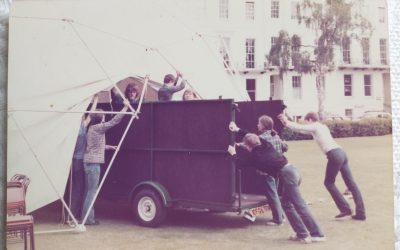I’m off to Vienna to rehearse four programmes of Mozart’s music which violinist Erich Höbarth and I are playing this season in Perth Concert Hall, Scotland’s newest concert hall (our first concert is on November 11). We’re tackling twelve of Mozart’s sonatas for piano and violin.
Piano and violin, I hear you say? Isn’t it ‘violin and piano’? Well, not according to Mozart who called them ‘sonatas for piano and violin’. In his letters, he mentions playing the piano parts himself ‘with the accompaniment of a violin’. That was how they were perceived until the nineteenth century and the age of the celebrity violinist, when things flipped around. These works, and many others like them, started to be listed as ‘violin sonatas’, and the piano part was suddenly ‘the accompaniment’. Even today the violinist is often the one with their photo on the record cover, the one whose name is in bigger font in the programme, or the only one whose name is mentioned at the end of the radio broadcast.
Why does this matter? It matters because the re-labelling tricks people into perceiving things falsely. They expect the violin part to be the leading voice, when in fact the meat of the musical narrative is in the piano part. If you approach these works expecting the violin part to be pre-eminent, you experience a kind of cognitive dissonance as you listen: often the violin is doing something quite modest, and you sense that the piano part is full of interest and information, but you don’t understand why such prominent material should be relegated to ‘the accompaniment’. The answer is that it isn’t an accompaniment. If you switch to hearing the music as piano with violin, everything falls into place. Of course you still need an excellent violinist, and perhaps even more importantly, an excellent musician, both of which I’m fortunate to have.
With more historical awareness, and with the intervention of a few strong-minded pianists, things are beginning to move back to Mozart’s original concept of ‘sonatas for piano with violin’. If you look up all the available recordings on Spotify, you’ll find about half of the duo sonatas advertised with the pianist’s name first, the other half with the violinist’s name first. This shows the confusion around the topic. It’s clearly a situation in transition, but at least there is movement.




I’m amazed at myself that I only discovered these marvellous works in recent months, through idly flicking through television channels and coming across the recordings of Ann-Sophie Mutter with Lambert Orkis on Sky Arts 2. I can’t recall whether they were described as violin and piano or piano and violin sonatas but as I watched/listened I was bowled over by Orkis’ contribution and how in some sonatas it’s the piano part which contains most of the “meat”! Is this because Mozart himself played the piano part originally as he did his concerti?
Reading your post makes me want to buy a plane ticket to Vienna to hear you and your violinist as I’m sure it would be a wonderful concert!!
Yes, I think you’re right that Mozart wrote the piano parts with his own skill as a pianist in mind – or certainly with the piano as the main protagonist. They are wonderful pieces of music.
Thank you for your kind comment about Vienna – in fact, only the rehearsals are in Vienna. The concerts are all in Scotland!
Yes, silly me read your original post far too quickly, and it registered after I clicked on the link to the concerts that the concerts are in Perth (Scotland, not Australia!! hahaha). I’ve booked for Sue my wife (Bob O’Neill’s sister if you remember us from Cerne Abbas last year!) and I to come to the first concert on November 11th (as we live in Carlisle it’s only a 2 1/2 hour drive) so very much looking forward to seeing and hearing you again!! It’s a bit nearer than Vienna!! hahahaha
There’s one that’s better known as the Piano Sonata in B flat, K. 570; he added a violin part and that version is included in my Peters edition of the duos, but it’s definitely a piano sonata with violin, not the other way about.
Long ago Columbia Records released a double LP of several of those pieces with Alexander Schneider on violin and Ralph Kirkpatrick on harpsichord. I remember them as very good, though I don’t know if there’s any historical case for harpsichord rather than piano (or late 18th century fortepiano.) Out of print for decades now; I wish someone would reissue them.
It is interesting to note that trios for ‘cello, violin and piano are always known as piano trios and not as violin trios. However, introduce a wind instrument and the nomenclature changes: Brahms’ horn trio, his clarinet trio, Beethoven’s clarinet trio, where the piano has many more solo passages than the clarinet. With Mozart one gets around the problem by using a name, the Kegelstatt trio for his trio for piano, clarinet and viola. Add a wind instrument to a string quartet and the same thing happens…and yet a string quintet is made up of 5 string instruments, whereas the ‘clarinet’ quintets by Brahms and Mozart do not bring together 5 clarinettists.
It’s down to marketing Steve…the clarinet sells tickets/ records cos it’s the best